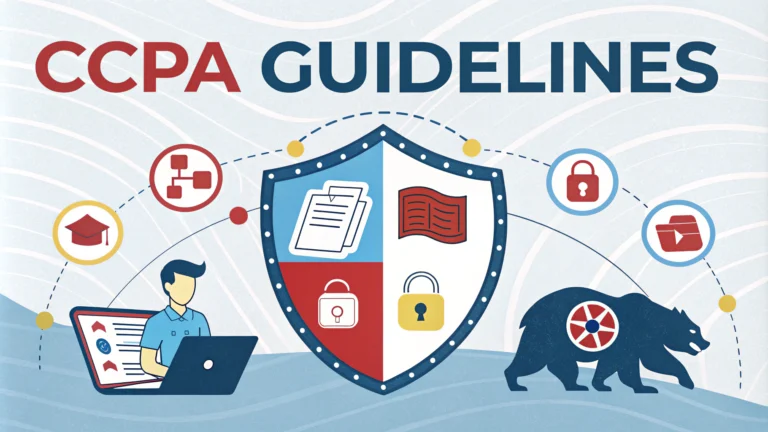CCPA penetration testing ensures organizations maintain compliance with California’s data privacy regulations while identifying security vulnerabilities in their systems.
Security teams must specifically test systems storing California residents’ personal information to meet CCPA’s strict requirements for data protection and breach prevention.
This guide covers the key penetration testing requirements under CCPA and provides practical steps for implementation.
Key CCPA Requirements for Security Testing
- Regular security assessments of systems containing personal information
- Documentation of testing procedures and results
- Verification of security controls protecting consumer data
- Testing of incident response capabilities
- Assessment of third-party service provider security
Essential Testing Areas
Networks storing California consumer data require thorough vulnerability scanning and penetration testing.
- Web application security testing
- Network infrastructure assessment
- Access control verification
- Encryption implementation review
- Data storage security testing
- API security assessment
Testing Frequency Requirements
| Risk Level | Recommended Testing Frequency |
|---|---|
| High Risk Systems | Quarterly |
| Medium Risk Systems | Bi-annually |
| Low Risk Systems | Annually |
Documentation Guidelines
Maintain detailed records of all testing activities:
- Test scope and methodology
- Identified vulnerabilities
- Remediation recommendations
- Evidence of fixes
- Executive summary reports
Third-Party Testing Requirements
Organizations must verify the security practices of vendors with access to consumer data:
- Review vendor security policies
- Assess data handling procedures
- Test vendor access controls
- Verify incident response capabilities
Testing Tools and Resources
Recommended tools for CCPA compliance testing:
- Nessus Professional (vulnerability scanning)
- Burp Suite Enterprise (web application testing)
- Metasploit Pro (penetration testing)
- Qualys (compliance scanning)
- Acunetix (web security testing)
Next Steps for Implementation
Contact certified security testing providers:
- SANS Institute: www.sans.org
- ISACA: www.isaca.org
- PCI Security Standards Council: www.pcisecuritystandards.org
Staying Compliant Through Testing
Regular testing and documentation form the foundation of ongoing CCPA compliance.
Consider engaging qualified third-party testers to ensure objective assessment of security controls.
Review and update testing procedures annually to address new threats and regulatory changes.
Testing Documentation Best Practices
Comprehensive documentation supports CCPA compliance and demonstrates due diligence:
- Create standardized testing templates
- Maintain version control for all reports
- Document remediation timelines
- Store results in secure locations
- Track historical testing data
Risk Assessment Integration
Align penetration testing with organizational risk assessments:
- Prioritize testing based on data sensitivity
- Focus on high-risk systems first
- Map testing coverage to risk matrices
- Adjust frequency based on risk levels
Incident Response Testing
Required Scenarios
- Data breach simulations
- Ransomware response
- Social engineering attacks
- System compromise scenarios
Documentation Requirements
- Response time metrics
- Communication workflows
- Recovery procedures
- Lesson learned reports
Maintaining Long-Term CCPA Security
Create a sustainable testing program through:
- Automated scanning implementation
- Continuous monitoring systems
- Regular staff training updates
- Evolving testing methodologies
- Proactive threat intelligence
Strengthening Your Security Posture Through Testing
CCPA compliance requires ongoing commitment to security testing and assessment. Organizations must maintain vigilant testing programs while adapting to new threats and regulatory requirements.
Success depends on thorough documentation, regular updates, and integration with broader security initiatives. Engage qualified testing partners and leverage appropriate tools to ensure comprehensive coverage of all CCPA requirements.
Remember that testing is not a one-time event but a continuous process essential for protecting California consumer data and maintaining regulatory compliance.
FAQs
- What role does penetration testing play in CCPA compliance?
Penetration testing helps organizations identify security vulnerabilities that could lead to unauthorized access of personal information protected under CCPA, ensuring robust data protection measures are in place. - How frequently should penetration testing be conducted under CCPA guidelines?
While CCPA doesn’t specify exact timeframes, best practices recommend conducting penetration tests at least annually or after significant system changes to maintain adequate security measures. - What types of personal information should be included in CCPA-focused penetration testing?
Testing should cover all systems storing or processing California residents’ personal information, including names, addresses, social security numbers, financial data, biometric data, and internet activity information. - Are there specific penetration testing methodologies required by CCPA?
CCPA doesn’t mandate specific testing methodologies, but organizations should follow industry-standard approaches like OWASP testing guidelines and ensure comprehensive coverage of both internal and external vulnerabilities. - What documentation is required for penetration testing under CCPA?
Organizations must maintain detailed records of penetration testing activities, including scope, methodology, findings, remediation plans, and verification of fixes to demonstrate due diligence in protecting consumer data. - How does CCPA’s private right of action relate to penetration testing?
If inadequate security measures lead to a data breach, consumers can sue companies directly. Regular penetration testing helps demonstrate reasonable security practices and can serve as evidence of due diligence. - What areas should CCPA penetration testing specifically focus on?
Testing should focus on access controls, encryption implementation, data storage systems, third-party integrations, authentication mechanisms, and any systems handling consumer personal information. - How does penetration testing align with CCPA’s requirement for reasonable security procedures?
Penetration testing is a key component of demonstrating reasonable security procedures by actively identifying and addressing vulnerabilities before they can be exploited. - What should be included in a CCPA penetration testing report?
Reports should include executive summary, scope, methodology, findings categorized by severity, risk assessment, detailed technical analysis, and specific recommendations for remediation. - How do CCPA penetration testing requirements differ from other privacy regulations?
While CCPA’s requirements are less prescriptive than regulations like GDPR, it still requires organizations to implement reasonable security measures, making penetration testing an essential security practice.







